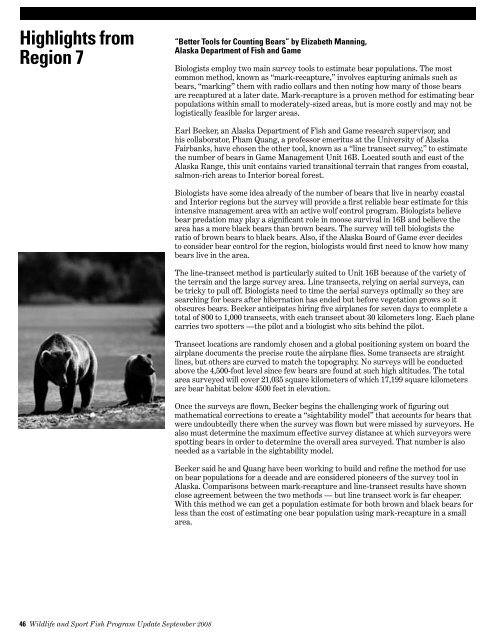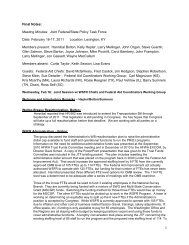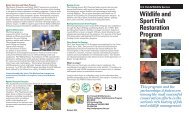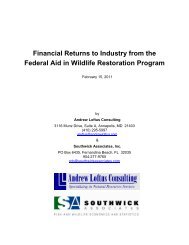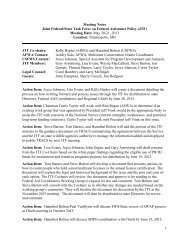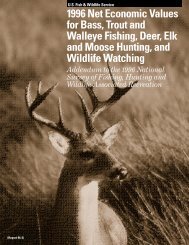Program Update - Wildlife and Sport Fish Restoration Program - U.S. ...
Program Update - Wildlife and Sport Fish Restoration Program - U.S. ...
Program Update - Wildlife and Sport Fish Restoration Program - U.S. ...
You also want an ePaper? Increase the reach of your titles
YUMPU automatically turns print PDFs into web optimized ePapers that Google loves.
Highlights from<br />
Region 7<br />
“Better Tools for Counting Bears” by Elizabeth Manning,<br />
Alaska Department of <strong>Fish</strong> <strong>and</strong> Game<br />
Biologists employ two main survey tools to estimate bear populations. The most<br />
common method, known as “mark-recapture,” involves capturing animals such as<br />
bears, “marking” them with radio collars <strong>and</strong> then noting how many of those bears<br />
are recaptured at a later date. Mark-recapture is a proven method for estimating bear<br />
populations within small to moderately-sized areas, but is more costly <strong>and</strong> may not be<br />
logistically feasible for larger areas.<br />
Earl Becker, an Alaska Department of <strong>Fish</strong> <strong>and</strong> Game research supervisor, <strong>and</strong><br />
his collaborator, Pham Quang, a professor emeritus at the University of Alaska<br />
Fairbanks, have chosen the other tool, known as a “line transect survey,” to estimate<br />
the number of bears in Game Management Unit 16B. Located south <strong>and</strong> east of the<br />
Alaska Range, this unit contains varied transitional terrain that ranges from coastal,<br />
salmon-rich areas to Interior boreal forest.<br />
Biologists have some idea already of the number of bears that live in nearby coastal<br />
<strong>and</strong> Interior regions but the survey will provide a first reliable bear estimate for this<br />
intensive management area with an active wolf control program. Biologists believe<br />
bear predation may play a significant role in moose survival in 16B <strong>and</strong> believe the<br />
area has a more black bears than brown bears. The survey will tell biologists the<br />
ratio of brown bears to black bears. Also, if the Alaska Board of Game ever decides<br />
to consider bear control for the region, biologists would first need to know how many<br />
bears live in the area.<br />
The line-transect method is particularly suited to Unit 16B because of the variety of<br />
the terrain <strong>and</strong> the large survey area. Line transects, relying on aerial surveys, can<br />
be tricky to pull off. Biologists need to time the aerial surveys optimally so they are<br />
searching for bears after hibernation has ended but before vegetation grows so it<br />
obscures bears. Becker anticipates hiring five airplanes for seven days to complete a<br />
total of 800 to 1,000 transects, with each transect about 30 kilometers long. Each plane<br />
carries two spotters ––the pilot <strong>and</strong> a biologist who sits behind the pilot.<br />
Transect locations are r<strong>and</strong>omly chosen <strong>and</strong> a global positioning system on board the<br />
airplane documents the precise route the airplane flies. Some transects are straight<br />
lines, but others are curved to match the topography. No surveys will be conducted<br />
above the 4,500-foot level since few bears are found at such high altitudes. The total<br />
area surveyed will cover 21,035 square kilometers of which 17,199 square kilometers<br />
are bear habitat below 4500 feet in elevation.<br />
Once the surveys are flown, Becker begins the challenging work of figuring out<br />
mathematical corrections to create a “sightability model” that accounts for bears that<br />
were undoubtedly there when the survey was flown but were missed by surveyors. He<br />
also must determine the maximum effective survey distance at which surveyors were<br />
spotting bears in order to determine the overall area surveyed. That number is also<br />
needed as a variable in the sightability model.<br />
Becker said he <strong>and</strong> Quang have been working to build <strong>and</strong> refine the method for use<br />
on bear populations for a decade <strong>and</strong> are considered pioneers of the survey tool in<br />
Alaska. Comparisons between mark-recapture <strong>and</strong> line-transect results have shown<br />
close agreement between the two methods –– but line transect work is far cheaper.<br />
With this method we can get a population estimate for both brown <strong>and</strong> black bears for<br />
less than the cost of estimating one bear population using mark-recapture in a small<br />
area.<br />
46 <strong>Wildlife</strong> <strong>and</strong> <strong>Sport</strong> <strong>Fish</strong> <strong>Program</strong> <strong>Update</strong> September 2008


